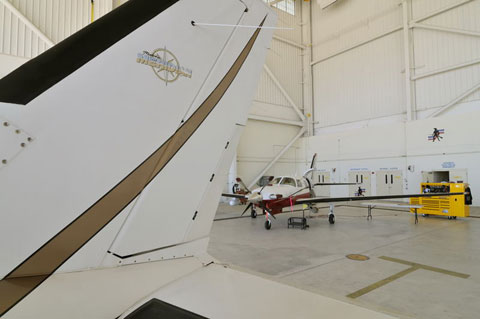
During a mid-August visit, Kestrel Aircraft Co. had two Piper Meridian turboprops in what will become its manufacturing facility at Maine’s Brunswick Executive Airport—formerly Naval Air Station Brunswick—and technicians for its new Kestrel Aeroworks division had removed most of the original panel from one of the aircraft.
Kestrel announced the new division at EAA AirVenture 2011. To create jobs at the Maine facility and generate revenues while certification progresses on the company’s own composite-construction, single-engine turboprop, Aeroworks will offer upgrades for existing high-performance airplanes, Kestrel Chairman and CEO Alan Klapmeier said. Initially the new division will focus on installing the Avidyne Release 9 panel in older Piper Meridian and Cirrus aircraft.
Work has already begun on the first Meridian, which will be used for certification of the Meridian enhancements; the second airframe will become a demonstrator. The Avidyne installation will include a new, more user-friendly panel; the relocation of some switches and circuit breakers; and easier pilot access to the Meridian’s cockpit—the original design favors shorter, thinner aviators. While pricing has not been announced, Klapmeier estimated at AirVenture that such an upgrade might cost $130,000.
Klapmeier said he is excited by what the Brunswick facility can bring to the Kestrel project. Maine is home to state-of-the-art composite technologies, he explained. “Early on, the thought was that aviation composites were way advanced when compared with marine [composites],” he said. “It’s largely reversed. Commercial aviation has certification as a driver, and it’s a less competitive environment. You can’t be fast movers with the technology.” The marine industry is very competitive and can change rapidly. “They started looking at new materials and, more important, new manufacturing techniques.”
This has instilled a focus on composites processes, time, and other elements, Klapmeier said. “Then you add on top of that wind turbine technology,” which is also growing in the region. The University of Maine’s Advanced Structures and Composites Center offers advanced structural testing capabilities and serves as a research hub for Maine’s boatbuilding industry.
“It’s the right kind of place to build composite airplanes,” Klapmeier said of Brunswick. When he and his brother launched Cirrus Aircraft in Duluth, he said they were starting from scratch when it came to composite manufacturing in the area. “Here, you have people who have a knowledge of composites.”
Brunswick also offers access to people with turbine aircraft experience who lived in the area—and want to come back. Klapmeier said there’s also a strong need for documentation and quality control. “This lines up very well with military paperwork.”
Kestrel currently employs about 45 people, divided between Brunswick and Duluth, Klapmeier said. Kestrel announced at AirVenture that its eight-seat, 320-knot turboprop will be powered by a Honeywell TPE331-14GR engine, flat rated to about 1,000 shaft horsepower for better high-altitude and high-temperature performance.



